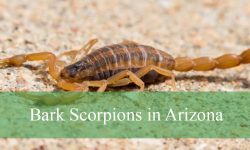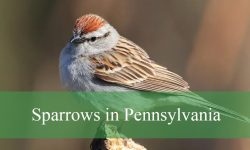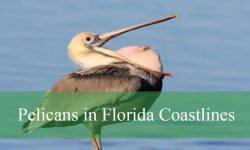Butterflies are some of the most exquisite creatures found in nature, their vibrant colors and delicate wings capturing the imagination of people worldwide. Among the many butterfly species, those with a combination of black and blue hues stand out due to their striking beauty. These butterflies aren’t just visually stunning, but also play an essential role in ecosystems, contributing to pollination and biodiversity.
In this article, we will explore 38 remarkable black and blue butterfly species, detailing their physical characteristics, habitats, and ecological significance. Whether you’re a butterfly enthusiast or a casual admirer of nature, you will find these species fascinating.
Different Types of Black and Blue Butterflies
Red-spotted Admiral
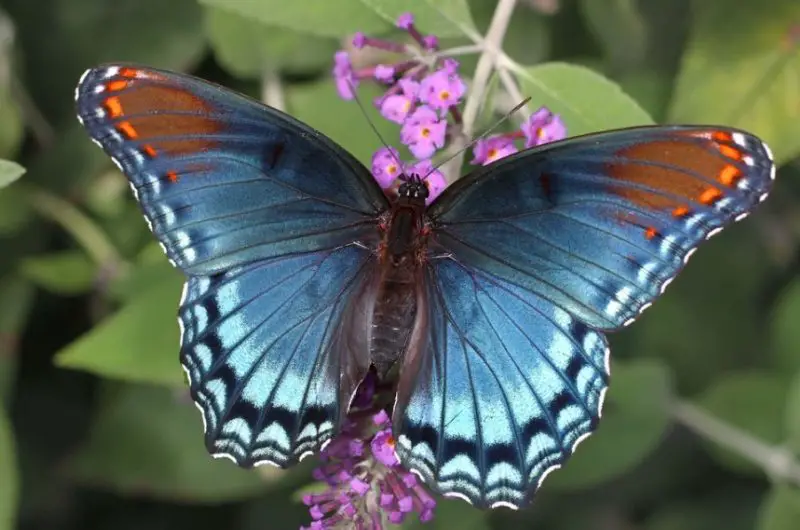
The Red-spotted Admiral (Limenitis arthemis) is a striking butterfly found throughout North America. Recognizable by its black wings adorned with blue margins and red spots, this species is a common sight in forests and woodlands.
With a wingspan ranging from 2 to 3 inches, the Red-spotted Admiral thrives in birch and evergreen forests, particularly in the Eastern United States. However, it can also be found at higher altitudes in various environments.
Unlike many other butterflies that primarily rely on nectar, this species has a diverse diet. It feeds on sap, carrion, and even dung, using these unconventional food sources to sustain itself. While plant nectar is an option, it is not the butterfly’s preferred food source.
Pipevine Swallowtail
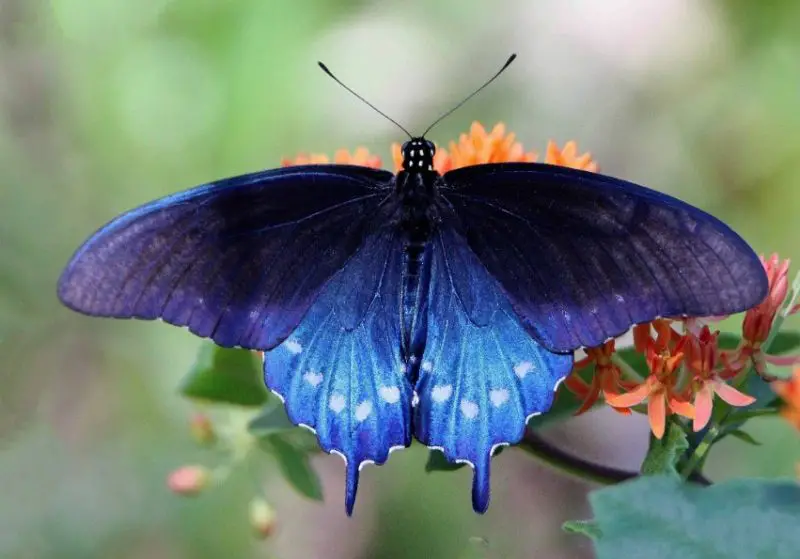
The Pipevine Swallowtail (Battus philenor) is a dazzling black butterfly with iridescent blue hindwings and light blue marginal spots. Males tend to display a more vivid blue than females, making them easy to distinguish.
This species is often seen fluttering around thistles and pink flowers, feeding on their nectar. Despite their beauty, Pipevine Swallowtail caterpillars face challenges in their early development. They often settle on toxic Aristolochia plants, which can sometimes prove fatal.
Despite these risks, the Pipevine Swallowtail remains a common species in North America, thriving in open fields, gardens, and woodlands where nectar-rich flowers grow.
Summer Azure
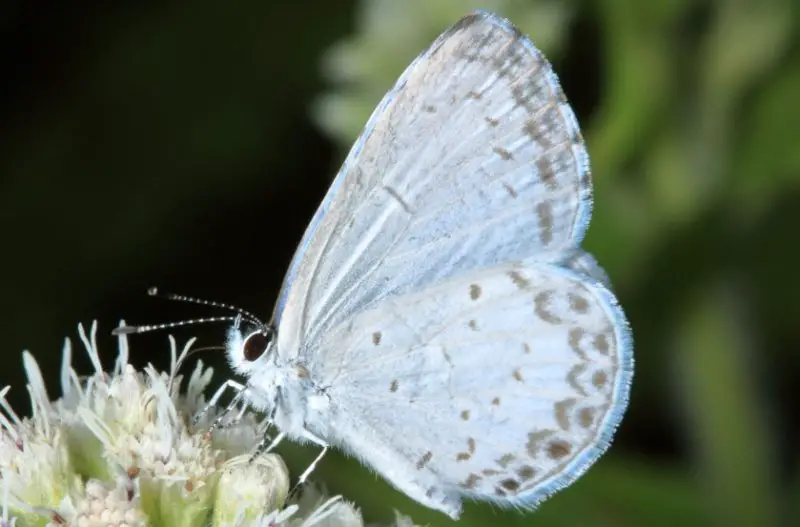
The Summer Azure (Celastrina neglecta) is a small yet captivating butterfly native to the Eastern and Central United States. It has an extended flight season, remaining active until October.
These butterflies display a light blue coloration with black margins, though females often appear slightly paler, almost white. Their wingspan is just over 1 inch, making them one of the smaller blue butterfly species.
Summer Azures primarily feed on nectar from various flowers, while their larvae prefer dogwood plants as a food source. The caterpillars, in contrast to the adult butterflies, are light green, blending in with their surroundings for protection.
Atala
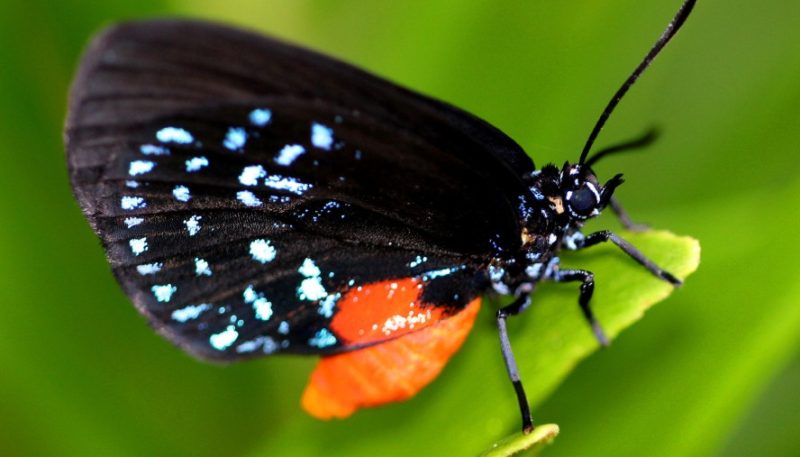
The Atala (Eumaeus atala) is a distinctive butterfly found in Florida’s subtropical climate. It is recognized by its black wings, blue spots, and a striking red abdomen.
This butterfly is slightly larger than other small species, with a wingspan of 1.5 to 2 inches. It thrives in warm, humid environments and relies on wild coffee and other subtropical flowers for nectar.
Due to its specialized habitat needs, the Atala population has declined, making it an endangered species. Though occasionally spotted in neighboring states, conservation efforts are crucial for its survival.
Mangrove Skipper
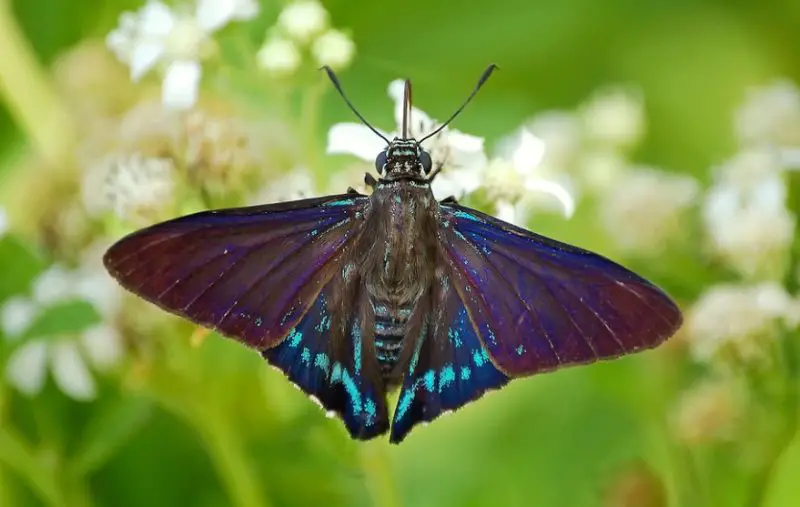
The Mangrove Skipper (Phocides pigmalion) is another Southern Florida butterfly that shares its habitat with the Atala. However, this species is darker in color, featuring a deep violet-blue hue with black veins and a black body.
With a wingspan of up to 2.5 inches, the Mangrove Skipper is larger than the Atala and can also be found in Mexico and Puerto Rico.
It primarily feeds on Shepherds’ needles and various wild citrus plants, favoring the nectar from warm-climate vegetation. Its adaptability to different subtropical regions ensures its continued presence across the southernmost parts of North America.
Common Checkered-Skipper
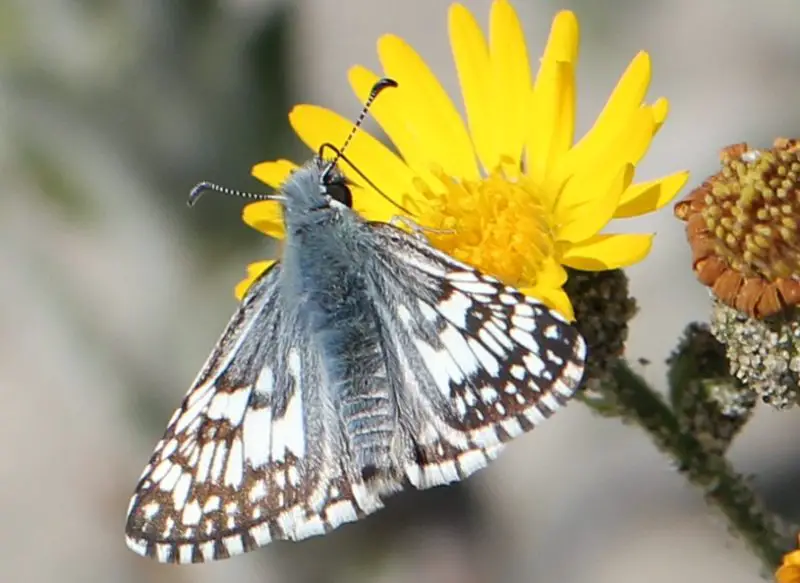
The Common Checkered-Skipper (Burnsius communis) is a widespread butterfly across the United States. Males have a blue and black body, making them easy to recognize.
This species is particularly active in the southern states, where it has an extended flight season from February to October. It thrives in open, sunlit areas, including fields and gardens.
Common Checkered-Skippers primarily feed on nectar, much like other skippers and moths. Their favorite nectar sources include Shepherd’s needle and various asters, which provide them with essential nutrients throughout their long active season.
Long-tailed Skipper
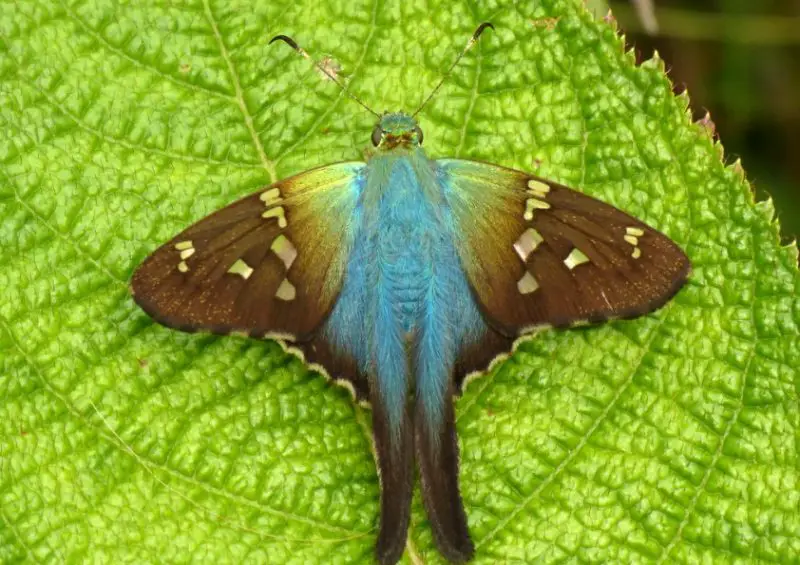
The Long-tailed Skipper (Urbanus proteus) is a partially blue butterfly with a metallic dark blue body. This coloration is present in both males and females, while their wings feature dark and light brown shades with white and black patterns.
Caterpillars of this species are known pests of wisteria plants, often causing damage to gardens. They have a green body and black head, which contrasts sharply with the blue-bodied adults.
As adults, Long-tailed Skippers primarily feed on nectar, with Shepherd’s needle being one of their preferred food sources. They are commonly found in warm regions where these plants grow abundantly.
Reakirt’s Blue
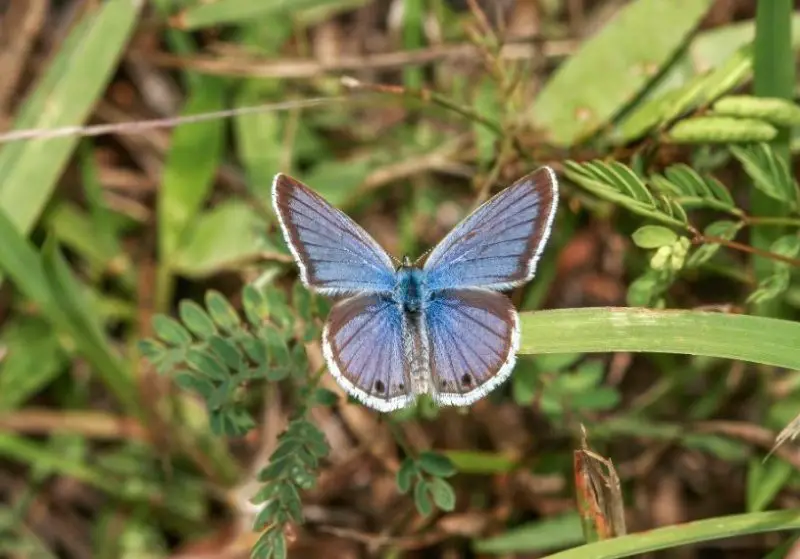
Reakirt’s Blue (Echinargus isola) is a delicate butterfly native to Southern America and Florida. It has a light blue body with black spots bordered by white, giving it a striking appearance.
This species thrives in various habitats, including open fields, gardens, and parks across Southern Florida. Unlike some other butterflies, it does not have strict habitat requirements.
Reakirt’s Blue primarily feeds on nectar and fruit, but it has specific preferences when it comes to plants. It is especially attracted to plants of the spearmint family, including mint and clover, making herb gardens a great place to spot them.
Silvery Blue
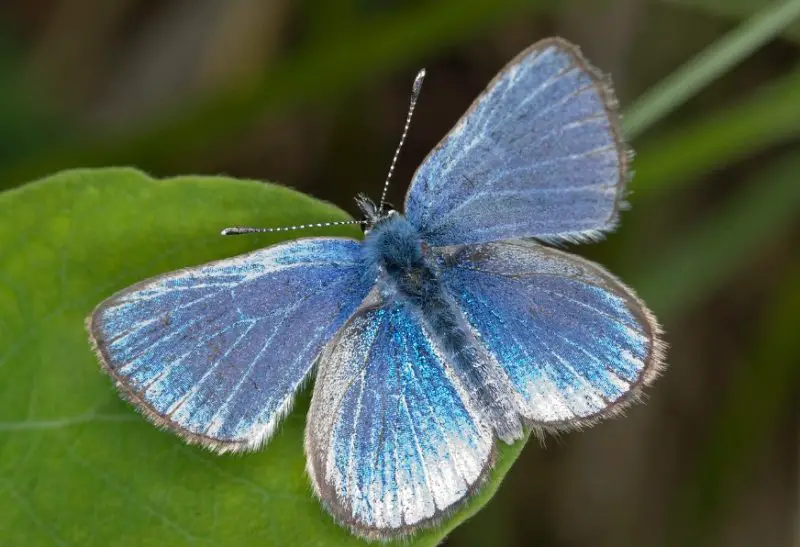
The Silvery Blue (Glaucopsyche lygdamus) gets its name from the silver tint on its blue wings. Both males and females share this coloration, though females often have darker blue wings.
They have white fringes, black spots, and black-bordered wings, with the white-bordered black spots standing out against their blue background.
Silvery Blues are found in open fields at various altitudes, thriving in regions outside the southern U.S. They are particularly associated with aster plants, which serve as their primary habitat and food source.
Tropical Checkered-Skipper
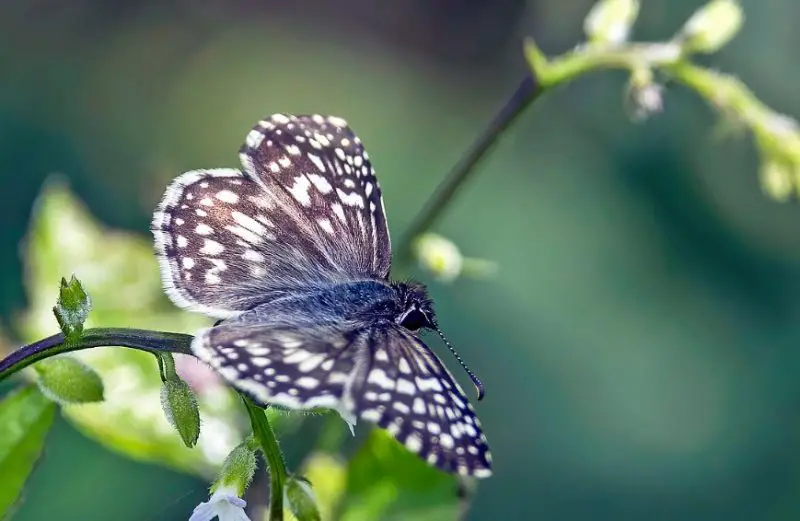
The Tropical Checkered-Skipper (Burnsius oileus) is a small but striking butterfly found in the Southeastern U.S. It has a wingspan of about 1.5 inches and features blue coloring with black wing margins and brown overlays. Multiple white spots on its wings add to its distinctive look.
Unlike some other skippers, this species has a scattered distribution, as it prefers very specific flowers for feeding. It primarily feeds on the pollen of various sida flowers, which are small pink, yellow, or orange blooms that attract many nectar-feeding insects.
Due to its selective diet, spotting the Tropical Checkered-Skipper can be challenging, but it remains a fascinating species in warm climates.
Great Purple Hairstreak
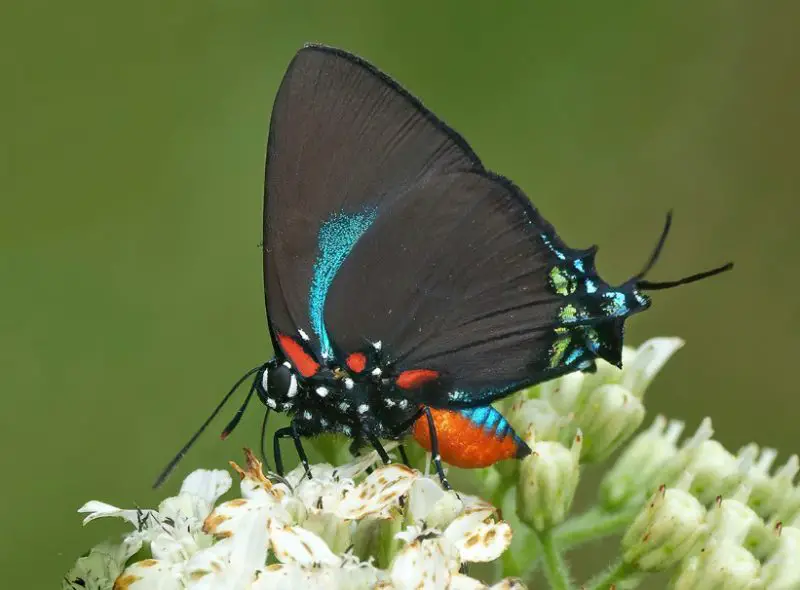
Great Purple Hairstreaks (Atlides halesus) are one of the most common dark blue and black butterflies in the United States.
Both males and females have a combination of blue and black coloring, though females are darker with wider black areas on their wings. Males, in contrast, have more iridescent blue, sometimes with a greener tint.
These butterflies rely on parasitic mistletoes for reproduction. They lay their eggs on mistletoe plants, and their caterpillars feed on the soft leaves of these hosts.
Great Purple Hairstreaks prefer mistletoes that grow in remote areas, ensuring that their larvae have access to suitable food sources.
Boisduval’s Blue
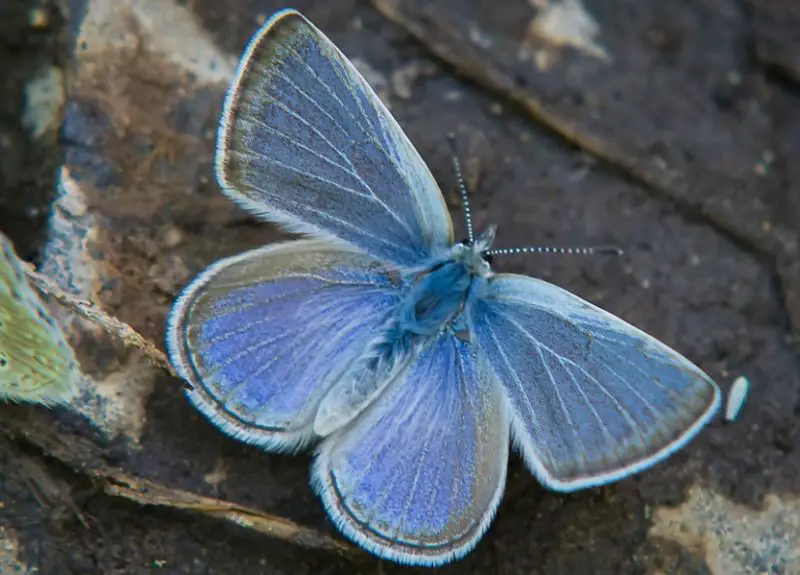
Boisduval’s Blue (Icaricia icarioides) is a light blue butterfly with black veins and black margins bordered by white.
This species is commonly found in the western United States, inhabiting meadows, alpine peaks, dunes, and open areas where food is abundant.
Boisduval’s Blue butterflies depend on wild buckwheat for sustenance. The females lay their eggs on lupine flowers, ensuring that their larvae have a consistent food source.
Once they pupate, these butterflies transition from lupines to wild buckwheat, continuing their lifecycle in the same habitat.
Spring Azure
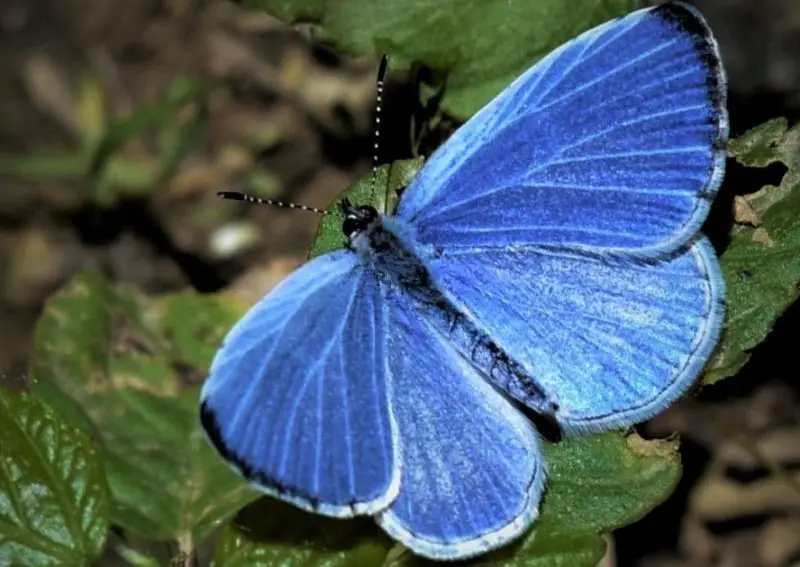
Spring Azures (Celastrina ladon) are widespread blue butterflies found throughout North America, including Alaska and Canada.
Males have a dark blue body with black-veined wings, black margins, and a white band. In contrast, females have a violet-blue hue, which appears lighter under direct sunlight.
Both males and females share the characteristic black and white margins, though females have slightly wider bands.
Spring Azures are known for their adaptability, thriving in various environments and feeding on nectar from a variety of plants.
Mexican Bluewing
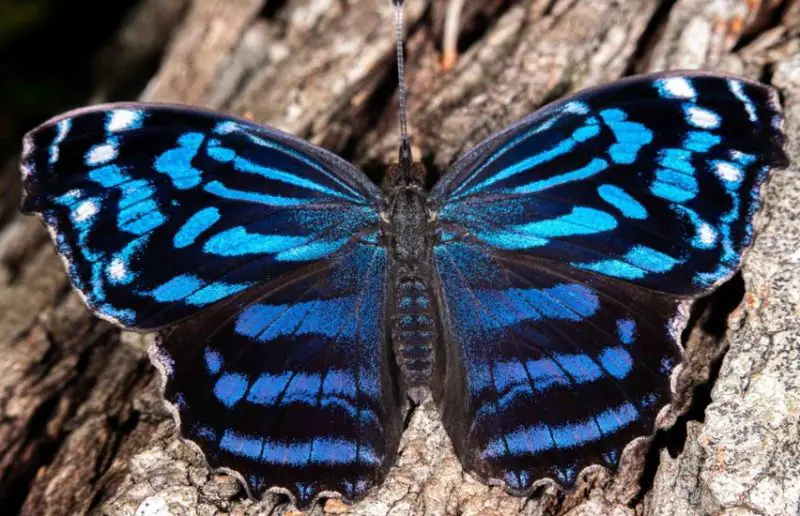
The Mexican Bluewing (Myscelia ethusa), also known simply as Bluewing, is a striking butterfly native to Central and North America.
Its wings feature alternating black and blue stripes with small white dots. While the dorsal side is blue and black, the ventral side is a mix of brown and black-brown, providing excellent camouflage when resting on tree trunks or leaves.
This ability to blend in makes the Mexican Bluewing difficult to spot in the wild. It is often found in forested areas where it can take advantage of its natural camouflage.
Sonoran Blue
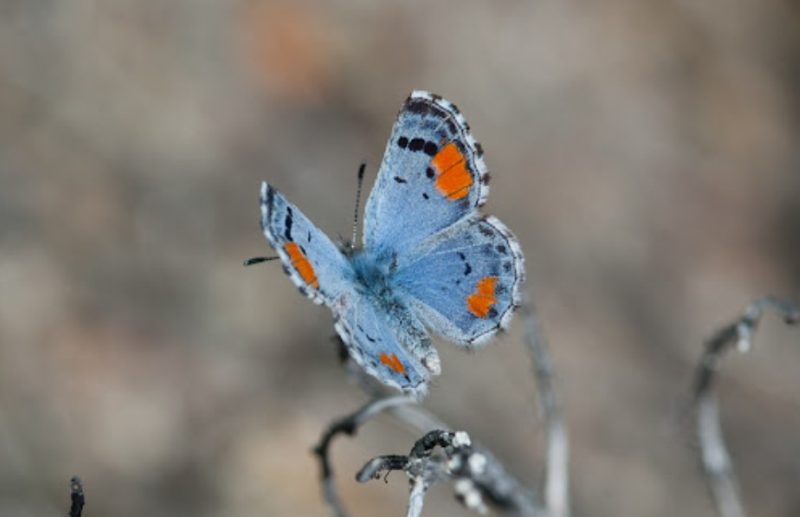
Sonoran Blue (Philotes sonorensis) is a butterfly native to the Sonoran Desert, primarily in California and Baja California.
Both males and females have a light blue coloration with black stripes, black margins, and black and red dots on their wings. The ventral side is brown with black and white markings.
Unlike many other butterflies, Sonoran Blue caterpillars feed primarily on succulents, a dietary adaptation to their arid desert habitat.
This species is uniquely suited to dry environments, making it a fascinating example of desert-adapted butterflies.
Guava Skipper
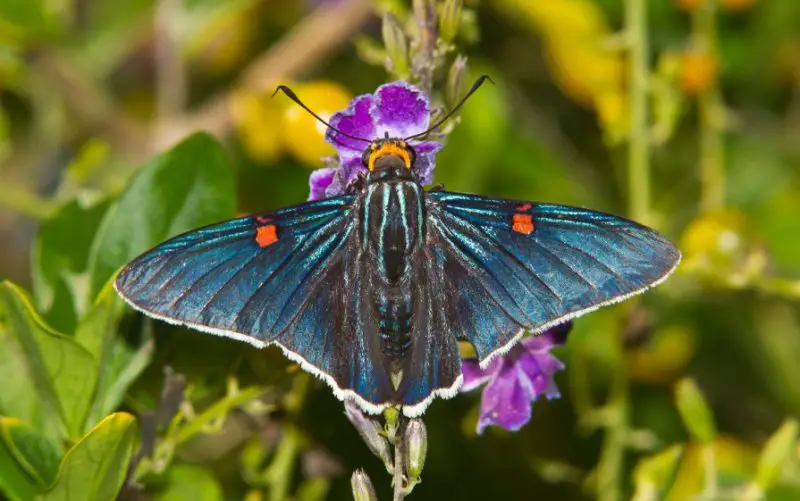
Guava Skippers (Phocides lilea) are some of the largest black and blue butterflies found across North, Central, and South America.
These butterflies have a significant impact on their host plants due to their size, with a maximum wingspan of 63mm.
Males have lighter blue wings with a black body featuring light blue stripes and red markings on the wings and head. In contrast, females are darker, with deep blue or black wings and similar light blue stripes on the body.
Their exact diet remains unclear due to their wide distribution, but adult Guava Skippers are believed to primarily feed on nectar.
Blue Metalmark
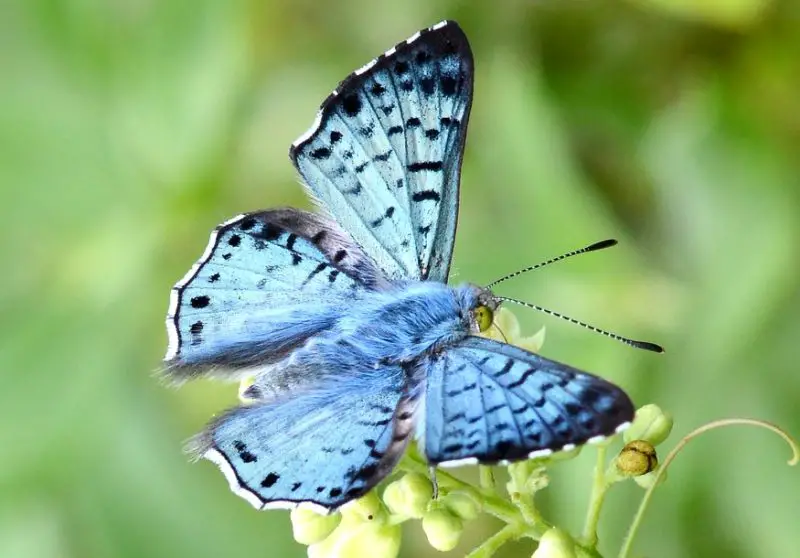
Blue Metalmark (Lasaia sula) is a striking butterfly named after its metallic blue wings.
The wings have varying shades of blue, with the outer forewings appearing deeper blue while the inner hindwings are a lighter shade. Black veins crisscross the wings, and males have additional white margins on the hindwings.
The ventral side of the wings is a mix of brown, white, and blue, with distinct black spots, differentiating it from the dorsal side.
Two-barred Flasher
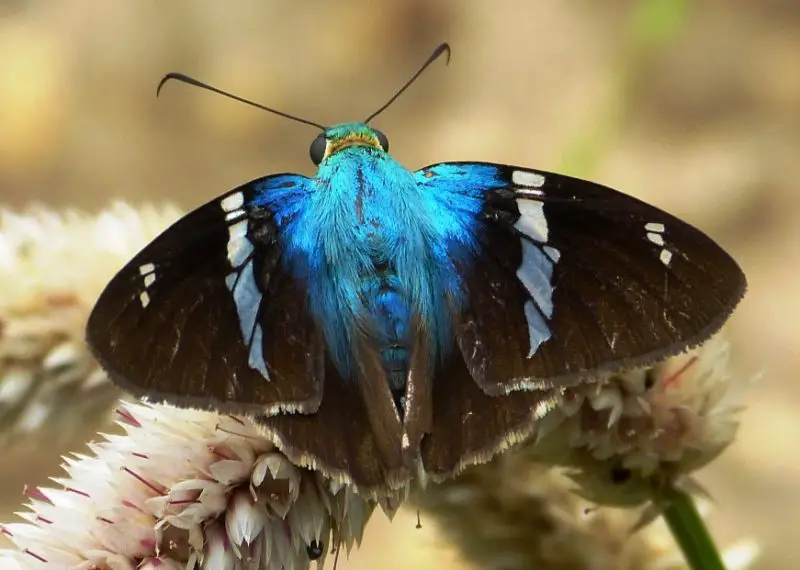
Two-barred Flasher (Astraptes fulgerator) is a skipper butterfly recognized by its distinctive wing bands.
It has two long and two short bands of white to light blue color contrasting against its metallic dark blue body. The wings are brown with visible dark brown veins, and its head is a vibrant blue.
These butterflies have a shimmering blue hue, especially noticeable under direct sunlight.
Florida Purplewing
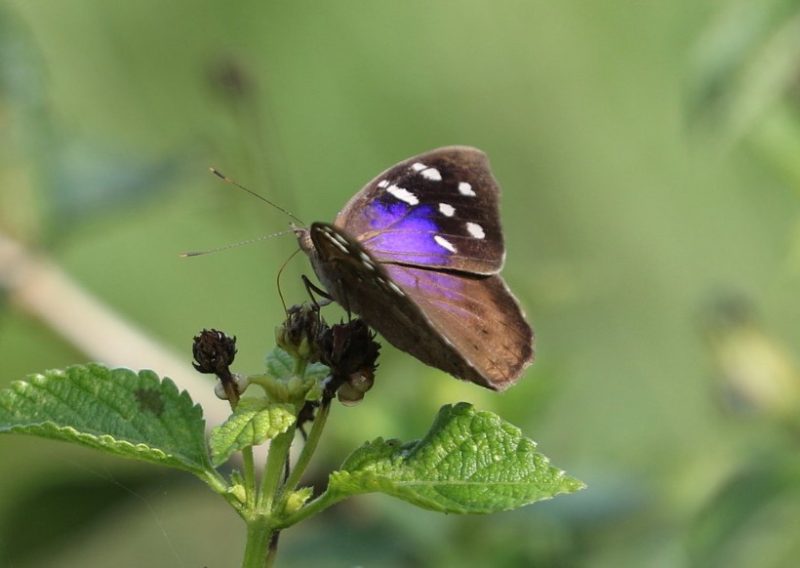
Florida Purplewing (Eunica tatila) is a butterfly with deep blue and black hues.
With a wingspan of over 2 inches, it is primarily found in southern Florida and parts of Texas. The butterfly’s vibrant blue-to-purple dorsal coloring is only visible when its wings are open.
When resting, it keeps its wings closed, revealing a brown ventral side that helps it blend in with dead leaves, serving as an effective camouflage against predators.
Gilbert’s Flasher
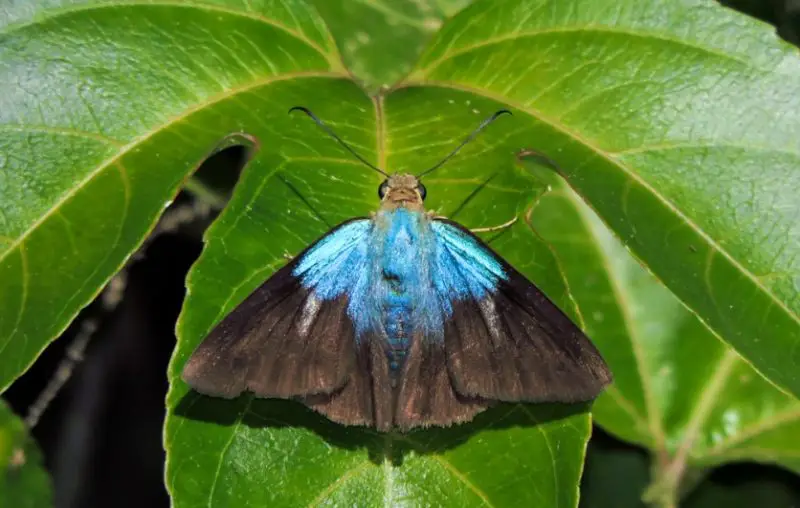
Gilbert’s Flasher (Telegonus alector) is a North American butterfly with a distinctive bi-colored appearance.
Its upper wings are blue, while the lower wings are brown, transitioning to black at the edges. The butterfly’s body is also bi-colored, with a light blue head and a lower abdomen that darkens toward the rear.
Males can be distinguished by two white dots or white stripes on their wings.
Blackened Bluewing
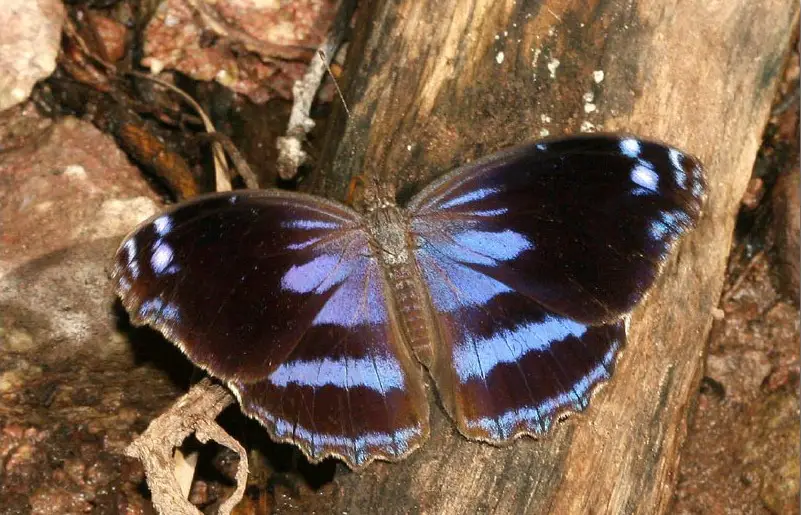
The Blackened Bluewing (Myscelia cyananthe) is a moth primarily found in the southwestern United States and Texas, with additional populations in Baja California.
True to its name, this species features a mix of black and blue, with dominant black patterns on its dorsal wings. The inner wings display a rich blue shade with black veins, and a small section near the body has a purple tint. Males may also exhibit white spots on the top of the wings.
Forrer’s Leafwing
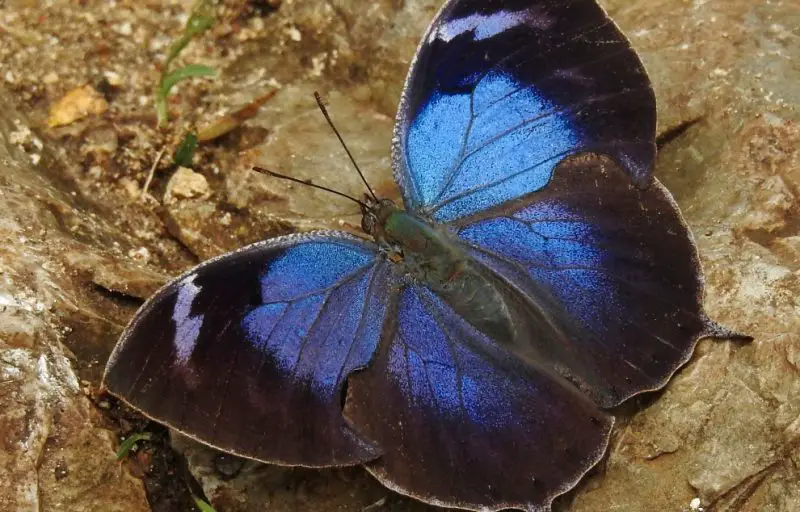
Forrer’s Leafwing (Memphis forreri) is a butterfly with a wingspan of up to 2 inches, featuring black and blue shades on its dorsal wings. The outer wings are primarily black, while the body has a muted blue or blue-gray coloration.
A key characteristic of this species is its leaf-like appearance when at rest. The ventral side is gray-brown, allowing it to blend in with tree branches as a defense mechanism against predators.
Forrer’s Leafwings are commonly found in woodlands, flying just above ground level.
Sara Longwing
![]()
Sara Longwing (Heliconius sara) is a large butterfly native to the southern U.S. and across North and South America. It has a wingspan of over 60mm and is known for its dark coloration.
Males have black and dark blue wings, with the darker color concentrated on the outer sections and the blue closer to the body. Both males and females display yellow bands on their wings, though females lack the blue coloring and have brown wings instead.
These butterflies feed on nectar from white and yellow flowers, particularly those of the Lantana genus. Their caterpillars develop on toxic plants, making them resistant to plant toxins and less appealing to predators.
Blue Admiral
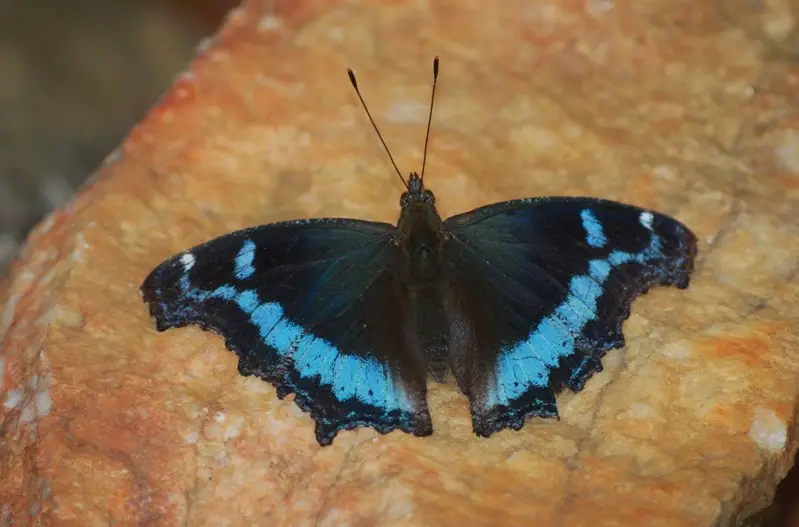
The Blue Admiral (Kaniska canace) is a widespread species in the U.S., known for its mostly black wings adorned with bright blue bands along the edges.
With a wingspan of nearly 3 inches, it is among the larger butterfly species. The ventral side is entirely different in coloration, with brown and light brown tones that help it blend into its surroundings when resting.
Blue Admirals are highly territorial and often chase away other butterflies to dominate their habitat.
Bell’s Longtail
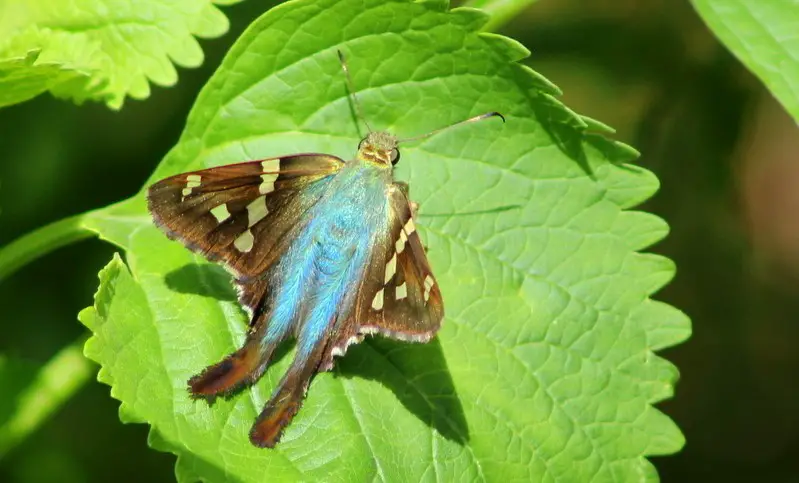
Bell’s Longtail (Urbanus alva) is a large butterfly found in southern U.S. regions, Central America, and parts of northern South America.
Its body and inner wings are metallic blue, while the upper forewings are a mix of light and dark brown. The hindwings are black, with additional light brown or tan spots scattered across the wings.
This species has long, black antennae, and males exhibit a striking blue-green coloration on the head and upper body.
Bell’s Longtail is most commonly found in Bolivia, Peru, and Guatemala.
Cascadia Blue
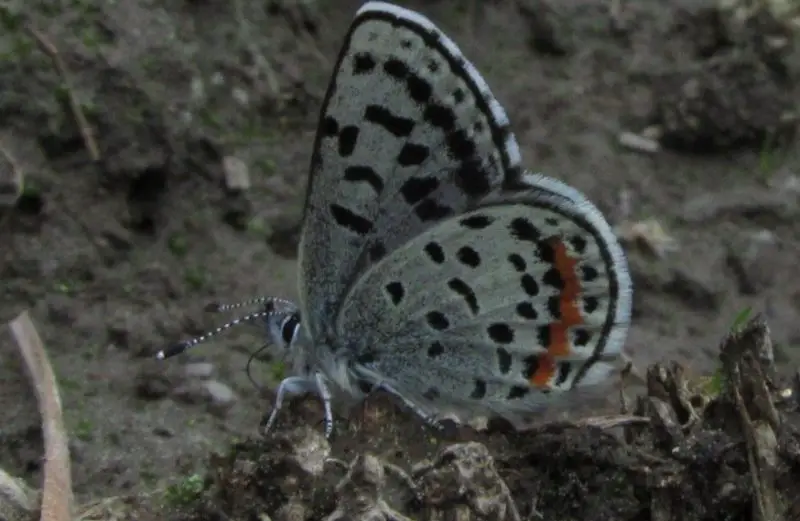
The Cascadia Blue (Euphilotes heracleoides) is a butterfly species with a light blue coloration that can sometimes appear grayish-white. Its body also has a light blue hue.
The wings feature small black dots across their surface, with fine black margins along the edges. A distinctive orange or red band appears on the outer wings.
Cascadia Blues are found in various habitats across North America, preferring open areas, ditches, and regions with short vegetation. They thrive in both low-altitude and high-altitude plateaus.
Blue Copper
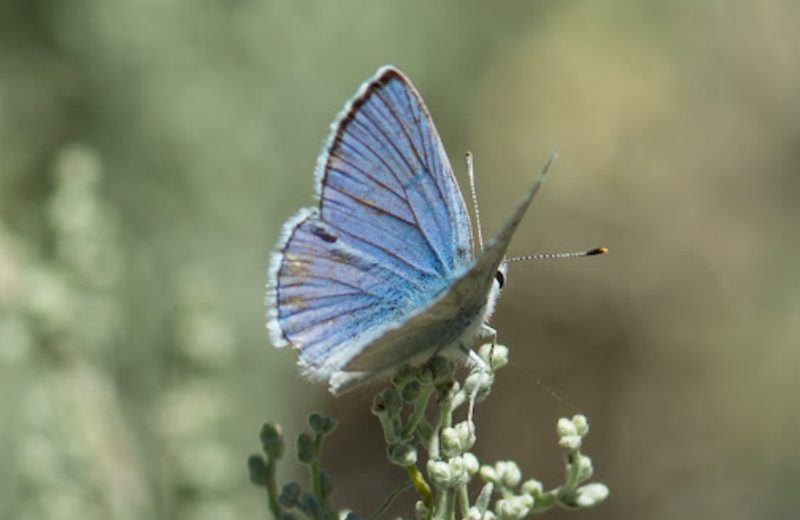
The Blue Copper (Tharsalea heteronea) is a butterfly dominated by blue and black coloring. It has a small wingspan of just over 1 inch.
Males have dark blue dorsal coloring with black veins, while females are light blue or blue-gray with black dots. Both genders have white margins around their wings.
This species is native to the western United States, with its range extending from California to Canada and around the Rocky Mountains.
Anna’s Blue
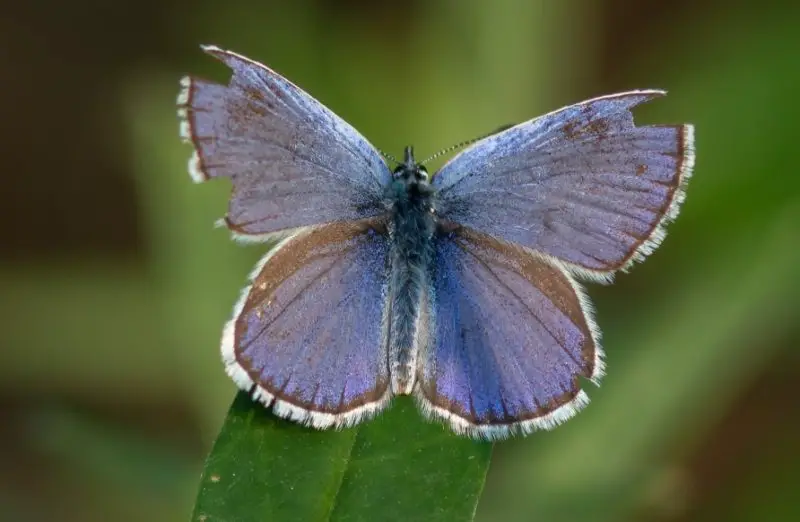
The Anna’s Blue (Plebejus anna) closely resembles the Blue Copper in males, with blue dorsal wings, black spots, and black margins.
However, the females of Anna’s Blue have distinct coloring, featuring brown, black, and orange hues instead of blue.
Like the Blue Copper, Anna’s Blue is found across the western U.S., but its habitat range is smaller.
Arctic Blue
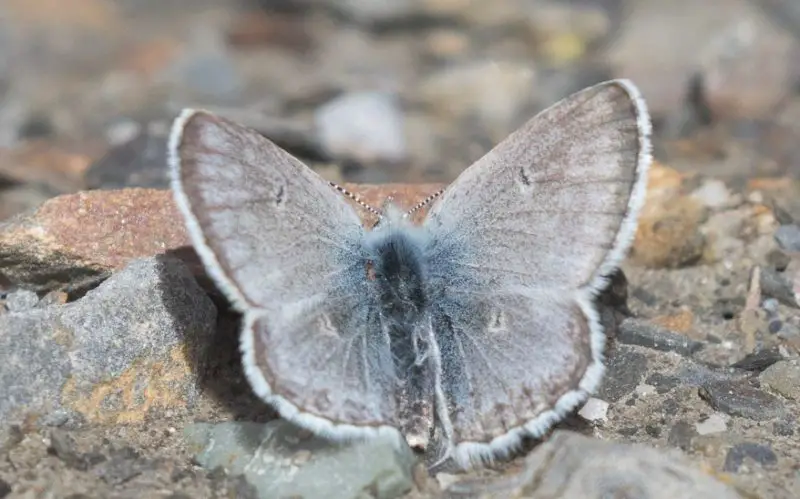
The Arctic Blue (Agriades glandon) is a member of the Lycaenidae family and is known for its ability to adapt to various environments, including the Arctic regions of Alaska.
Males have dark blue inner wings, a blue body, and a blue head. The outer wings are black with white margins and scattered black dots.
Females have muted blue tones with black wings, but both genders share the characteristic white margins.
Arctic Blues are highly adaptable and can be found in meadows, mountainous regions, and woodlands.
Square-spotted Blue
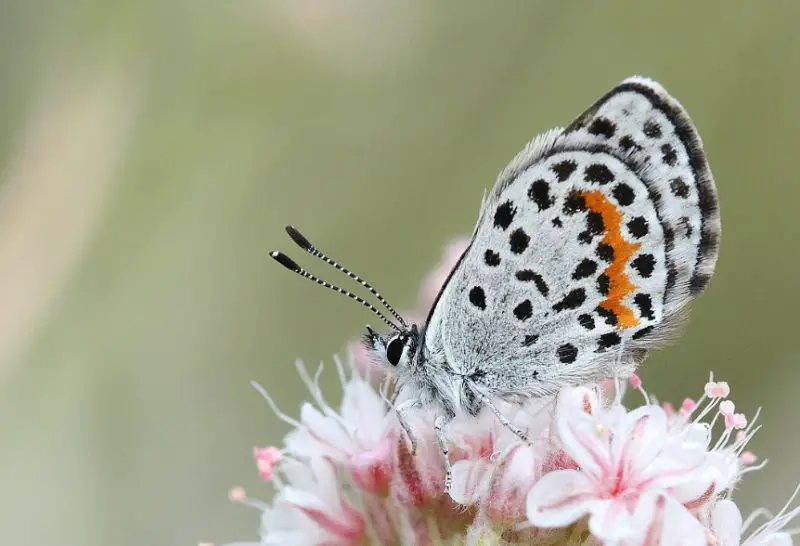
The Square-spotted Blue (Euphilotes battoides) is a small butterfly commonly found in the Western and Central regions of North America. Males of this species have distinctive light blue wings adorned with black dots and orange stripes, while females typically have brown wings. The body of both males and females is light blue-gray.
These butterflies are usually seen in open areas, including grasslands and meadows. They primarily feed on nectar, particularly from wild buckwheat, which is a common plant among blue and black butterfly species.
The Square-spotted Blue is known for its striking appearance and preference for habitats with abundant sunlight and low vegetation.
How to Identify and Differentiate Black and Blue Butterflies
Identifying black and blue butterflies can be challenging due to their diverse appearances. However, there are a few key features to look for that can help in identification:
- Wing Color and Patterns: Look at the shades of blue and black on the wings. The intensity of the blue and the arrangement of spots or stripes can help differentiate species.
- Size and Shape: Some black and blue butterflies, like the Great Mormon, are much larger, while others, like the Lime Butterfly, are smaller.
- Behavior: Observe the butterfly’s flying style. Some species, like the Common Bluebottle, are fast flyers, while others, like the Black Swallowtail, tend to flutter slowly.
The Importance of Butterflies in Environmental Protection and Biodiversity
Butterflies play a crucial role in the environment as pollinators, contributing to the health of ecosystems by facilitating plant reproduction. They also serve as indicators of ecosystem health, as changes in butterfly populations can signal shifts in environmental conditions.
Protecting butterfly habitats and ensuring biodiversity is vital for maintaining these essential ecological roles. Conservation efforts are necessary to safeguard these beautiful creatures and the ecosystems they support.


